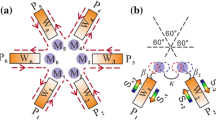Abstract
Three-port circulators based on magneto-optical resonators in 2D photonic crystals with low symmetry are investigated. We consider different geometries of the circulators in photonic crystals with triangular and square unit cells. All of the three-ports possess only one specific element of symmetry named antiplane of symmetry. The theoretical part of our paper concerns scattering matrix analysis for different regimes of circulation. In particular, we define the scattering matrices of ideal circulator and a special type of conditions which allow one to transform the non-reciprocal three-port in ideal circulator. One case of non-ideal circulators is considered as well. We also discuss some peculiarities of a special regime of the circulators when they are used as isolators. Finally, one example of the circulator simulations with calculated frequency responses in photonic crystals based on triangular unit cells is presented.









Similar content being viewed by others
References
Wang, Z., Fan, S.: Optical circulators in two-dimensional magneto-optical photonic crystals. Opt. Lett. 30, 1989–1991 (2005)
Smigaj, W., Romero-Vivas, J., Gralak, B., Magdenko, L., Dagens, B., Vanwolleghem, M.: Magneto-optical circulator designed for operation in a uniform external magnetic field. Opt. Lett. 35, 568–570 (2010)
Fan, F., Chang, S.J., Niu, C., Hou, Y., Wang, X.H.: Magnetically tunable silicon-ferrite photonic crystals for terahertz circulator. Opt. Commun. 285, 3763–3769 (2012)
Dmitriev, V., Kawakatsu, M., Souza, F.: Compact three-port optical 2D photonic crystal-based circulator of W-format. Opt. Lett. 37, 3192–3194 (2012)
Wang, Q., Ouyang, Z., Tau, K., Lin, M., Ruan, S.: T-shaped optical circulator based on coupled magneto-optical rods and a side-coupled cavity in a square-lattice photonic crystal. Phys. Lett. A 376, 646–649 (2012)
Wang, Z., Fan, S.: Suppressing the effect of disorders using time-reversal symmetry breaking in magneto-optical photonic crystals: An illustration with a four-port circulator. Photonics Nanostructures Fundam. Appl. 4, 132–140 (2006)
Dmitriev, V., Portela, G.: Multifunctional two-dimensional photonic crystal optical component based on magneto-optical resonator: nonreciprocal two-way divider-switch, nonreciprocal 120 deg bending-switch, and three-way divider. Opt. Eng. 53, 115102 (2014)
Helszajn, J.: Nonreciprocal Microwave Junctions and Circulators. Wiley, New York (1975)
Barybin, A., Dmitriev, V.: Modern Electrodynamics and Coupled-Mode Theory: Application to Guided-Wave Optics. Rinton, New Jersey (2002)
Helszajn, J.: The Stripline Circulators: Theory and Practice. Wiley-IEEE Press, New Jersey (2008)
Lax, B., Button, K.: Microwave Ferrites and Ferrimagnetics. McGraw-Hill, New York (1962)
Sadiku, M.: Elements of Electromagnetics. Oxford University Press, New York (2014)
Sekhar, M.C., Singh, M.R., Basu, S., Pinnepalli, S.: Giant faraday rotation in \(\text{ Bi }_{x} \text{ Ce }_{3-{x}}\text{ Fe }_5 \text{ O }_{12}\) epitaxial garnet films. Opt. Express 20, 9624–9639 (2012)
Nagaev, E.L.: Ferromagnetic and antiferromagnetic semiconductors. Sov. Phys. Uspekhi 18, 863–892 (1975)
Methfessel, S., Mattis, D.C.: Magnetic Semiconductors (in Handbuch der Physik). Springer, Berlin (1968)
Zvezdin, A.K., Khotov, V.A.: Modern Magneto-Optics and Magneto-Optical Materials. IOP, Bristol (1997)
Acknowledgments
This work was supported by the Brazilian agency National Counsel of Technological and Scientific Development.
Author information
Authors and Affiliations
Corresponding author
Appendix: Details of optical fork-type circulator
Appendix: Details of optical fork-type circulator
A detailed geometry of the proposed optical fork-like circulator is given in Fig. 10. The periodic structure of the employed PhC is represented by the circular white holes (unnumbered ones) in Fig. 10. Each of them has radius equal to 0.3a, where a is the lattice constant. For \(\lambda =1.55\,\upmu \mathrm{m}\), a = 480 nm.
The resonant cavity corresponds to the central part of the device (circular holes No. 0, 1, 2, and 3). The radius of the orange central hole (No. 0) is 0.9a. The radius of 12 blue holes (No. 1) is 0.38a, and they form the ring with radius \(R_1=1.58a\). On the other hand, the radius of 18 red holes (No. 2) is 0.3a and they form the ring with radius \(R_2=2.69a\). Finally, the radius of six green holes (No. 3) is 0.3a and they form the ring with radius \(R_3=3.76a\).
One needs to project geometry of the resonator that provides at the central frequency of the circulator the maximum values of isolation and the minimum values of insertion losses for all the ports. In Fig. 11a, one can see that the direct connections of port 2 and port 3 to the resonator without any modification give a large dislocation of the peak of \(S_{32}\) in comparison with \(S_{13}\) and \(S_{21}\). In order to solve this problem, we have modified two black holes (No. 4). In the non-optimized circulator, the radius of them is 0.3a and \(\Delta {x} = 0\). Choosing the radius of these holes equal to 0.288a and \(\Delta {x} = 0.173a\), we come to the frequency responses of the circulator shown in Fig. 11b.
Rights and permissions
About this article
Cite this article
Dmitriev, V., Portela, G. & Martins, L. Three-port circulators with low symmetry based on photonic crystals and magneto-optical resonators. Photon Netw Commun 31, 56–64 (2016). https://doi.org/10.1007/s11107-015-0529-8
Received:
Accepted:
Published:
Issue Date:
DOI: https://doi.org/10.1007/s11107-015-0529-8






